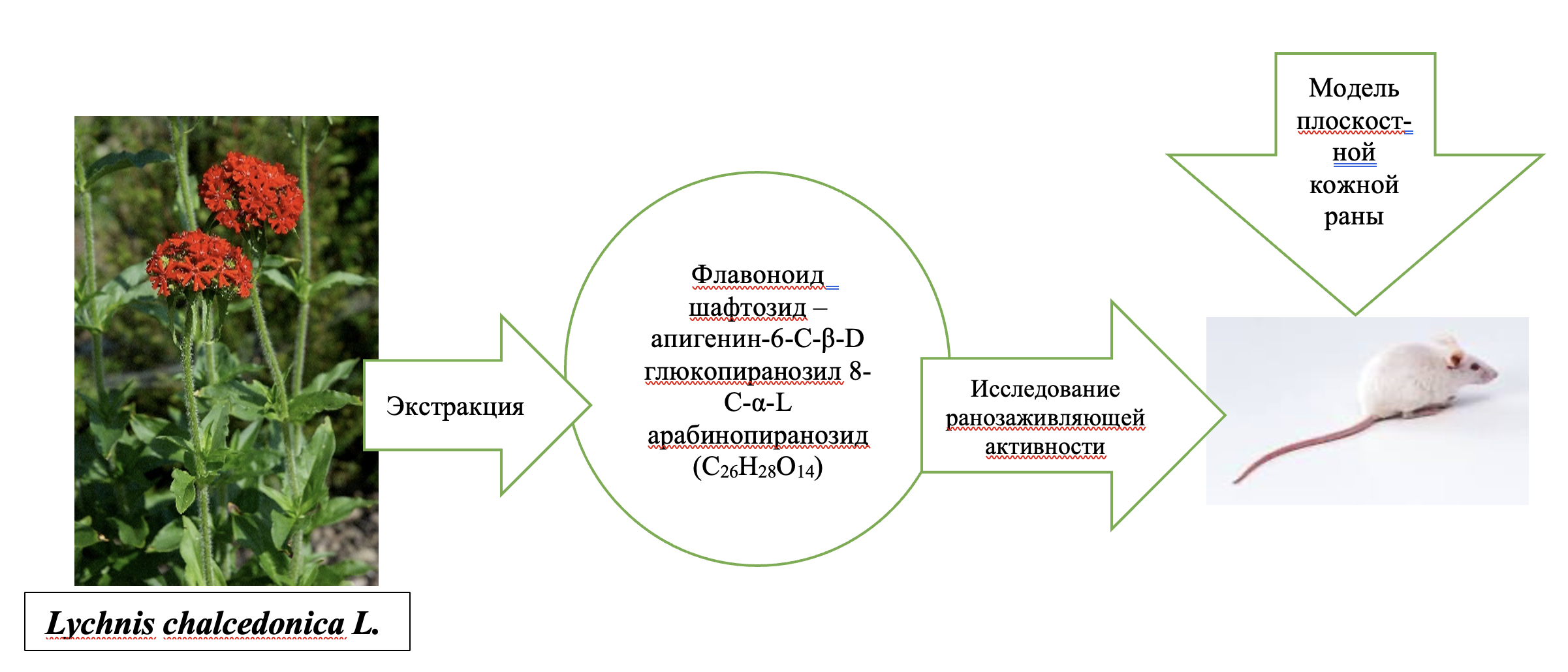Исследование ранозаживляющей активности флавоноида шафтозида, выделенного из Lyсhnis chalcedonica
DOI:
https://doi.org/10.18413/rrpharmacology.9.10034Аннотация
Введение. Данная статья посвящена исследованию ранозаживляющей активности флавоноида шафтозида – апигенин -6-C-β-D глюкопиранозил 8-C-α-L арабинопиранозид (C26H28O14), выделенного из надземной части Lyсhnis chalcedonica L.
Материалы и методы. Эксперименты проводились на половозрелых беспородных мышах-самцах CD-1. Ранозаживляющее действие шафтозида исследовали на модели плоскостной кожной раны. Шафтозид наносили наружно (местно) в виде водного раствора с помощью пипетки по 100 мкл на рану в концентрациях 0,1 мкг/мл, 1,5 мкг/мл, 3,0 мкг/мл, начиная с первого дня после индуцирования раны, 1 раз в сутки в течение всего периода заживления раневого повреждения до полной эпителизации. В качестве положительного контроля использовали сок алоэ по 100 мкл на рану. Контрольным животным наносили растворитель (воду) по 100 мкл на рану.
Результаты и обсуждение. Водный раствор флавоноида шафтозида показал выраженный ранозаживляющий эффект на модели плоскостной кожной раны у мышей. Ускорение сроков заживления ран при нанесении его в концентрации 0,1 мкг/мл составила 23,8 %, как и в группе положительного контроля (сок алоэ). Шафтозид в концентрациях 1,5 мкл/мл и 3,0 мкл/мл также сокращал сроки заживления, но чуть меньше (на 14,3 %), однако, морфометрическое исследование показало, что под влиянием шафтозида в концентрации 3,0 мкг/мл у 50 % мышей была полноценная эпителизация, только у 10 % животных дефект был покрыт тонким эпителием, что достоверно было меньше, чем в группе контроля и группе, которым наносили сок алоэ (препарат сравнения).Шафтозид в концентрациях 0,1 мкг/мл и 1,5 мкг/мл в сравнении с контрольными показателями также достоверно улучшал качество регенерата, но в сравнении с соком алоэ, наблюдалась только тенденция к усилению эффекта.
Заключение. В нашем исследовании впервые показано выраженное ранозаживляющее действие водного раствора флавоноида шафтозида из Lyсhnis chalcedonica на модели плоскостной кожной раны у мышей.
Графическая аннотация

Ключевые слова:
Плоскостная кожная рана, Lyсhnis chalcedonica L., флавоноид шафтозидБиблиографические ссылки
Albahri G, Badran A, Hijazi A, Daou A, Baydoun E, Nasser M, Merah O (2023) The therapeutic wound healing bioactivities of various medicinal plants. Life (Basel) 13(2): 317. [PubMed] [PMC]
Baron J, Glatz M, Proksch E (2020) Optimal support of wound healing: New insights. Dermatology 236(6): 593-600. https://doi.org/10.1159/000505291 [PubMed]
Blinova EV, Mironov MA, Blinov DS (2018) Regeneration of an infected skin wound against the background of topical exposure to salts of n-acetyl-6-aminohexanoic acid. The Journal of Scientific Articles Health and Education Millennium [Zhurnal Nauchnykh Statei Zdorov'e i Obrazovanie v XXI Veke] 20(7): 80–83. http://dx.doi.org/10.26787/nydha-2226-7425-2018-20-7-80-83 [in Russian]
Efimov EA (1975) Post-traumatic Skin Regeneration (Experimental study). Medicine, Moscow, 166 pp.
Fedoseeva LM, Kiryakova VO (2017) Determination of quality indicators of the encapsulated dosage form with hemp nettle herb dry extract. Chemistry of Plant Raw Materials [Khimiya Rastitel'nogo Syr'ya] 2: 149–153. https://doi.org/10.14258/jcprm.2017021717 [in Russian]
Fenchin KM (1979) Wound Healing. Zdorovue, Kyiv,167 pp.
Frolova NIu, Mel'nikova TI, Buriakina AV, Vishnevskaia EK, Avenirova EL, Sivak KV, Karavaeva AV (2009) Methodical approaches to the experimental study of dermatotropic drugs. Experimental and Clinical Pharmacology [Eksperimentalnaya i Klinicheskaya Farmakologia] 72(5): 56–60. [PubMed] [in Russian]
Lakin GF (1980) Biometrics. Vyschaya Shkola, Moscow, 293 pp.
Liu M, Liu C, Chen H, Huang X, Zeng X, Zhou J, Mi S (2017) Prevention of cholesterol gallstone disease by schaftoside in lithogenic diet-induced C57BL/6 mouse model. European Journal of Pharmacology 815: 1-9. https://doi.org/10.1016/j.ejphar.2017.10.003 [PubMed]
Mashkovsky MD (2021) Medicines. Novaya volna, Moscow, 1216 pp. [in Russian]
Nosenko MA, Ambaryan SG, Drutskaya MS (2019) Anti-inflammatory cytokines and healing of skin wounds in mice. Molecular Biology [Molekulyarnaya Biologiya] 53(5): 741–754. [in Russian]
Olennikov DN, Kashchenko NI (2020) Ecdysteroids and glycosylflavones Silene Sibirica (Caryophyllaceae). Chemistry of Plant Raw Materials [Khimiya Rastitel'nogo Syr'ya] 4: 109–119. https://doi.org/10.14258/jcprm.2020047432 [in Russian]
Pazyar N, Yaghoobi R, Rafiee E, Mehrabian A, Feily A (2014) Skin wound healing and phytomedicine: A review. Skin Pharmacology and Physiology 27(6): 303-310. https://doi.org/10.1159/000357477 [PubMed]
Petrova NV, Medvedeva NA (2020) Component composition and biological activity of species of the genus Viola (Violaceae) of the Russian flora. Chemistry of Plant Raw Materials [Khimiya Rastitel'nogo Syr'ya] 2: 19–45. https://doi.org/10.14258/jcprm.2020026305 [in Russian]
Reinke JM, Sorg H (2012) Wound repair and regeneration. European Surgical Research 49(1): 35-43. https://doi.org/10.1159/000339613 [PubMed]
Xiong F, Wang H, Jiang Z, Huo M, Yan C, Zheng C, Gu N (2015) Integrated pharmacokinetics and biodistribution of multiple flavonoid C-glycosides components in rat after oral administration of Abrus mollis extract and correlations with bio-effects. Journal of Ethnopharmacology 163: 290-296. https://doi.org/10.1016/j.jep.2014.12.067 [PubMed]
Zhou K, Wu J, Chen J, Zhou Y, Chen X, Wu Q, Xu Y, Tu W, Lou X, Yang G, Jiang S (2019) Schaftoside ameliorates oxygen glucose deprivation-induced inflammation associated with the TLR4 Myd88/Drp1-related mitochondrial fission in BV2 microglia cells. Journal of Pharmacological Sciences 139(1): 15–22. https://doi.org/10.1016/j.jphs.2018.10.012 [PubMed]
Zibareva LN, Amosova EN, Krylova SG (2021) Plants of the genera Silene L. and Lychnis L. (Caryophyllaceae): composition of chemical components and biological activity. Tomsk State University Publishing House, Tomsk, 469 pp. [in Russian]
Zibareva LN, Filonenko ES, Chernyak EI, Morozov SV, Kotelnikov OA (2022). Flavonoids of some plant species of the genus Silene. Chemistry of Plant Raw Materials [Himiya Rastitel'nogo Syr'ya] 3: 109-118. https://doi.org/10.14258/jcprm.20220310592
 Русский
Русский
 English
English

